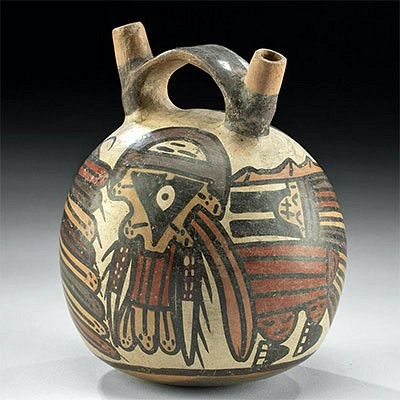Prehistoric Anasazi Tularosa Black on White Pitcher
Lot 101
About Seller
Artemis Gallery
686 S Taylor Ave, Ste 106
Louisville, CO 80027
United States
Selling antiquities, ancient and ethnographic art online since 1993, Artemis Gallery specializes in Classical Antiquities (Egyptian, Greek, Roman, Near Eastern), Asian, Pre-Columbian, African / Tribal / Oceanographic art. Our extensive inventory includes pottery, stone, metal, wood, glass and textil...Read more
Categories
Estimate:
$1,500 - $2,250
Absentee vs Live bid
Two ways to bid:
- Leave a max absentee bid and the platform will bid on your behalf up to your maximum bid during the live auction.
- Bid live during the auction and your bids will be submitted real-time to the auctioneer.
Bid Increments
| Price | Bid Increment |
|---|---|
| $0 | $25 |
| $300 | $50 |
| $1,000 | $100 |
| $2,000 | $250 |
| $5,000 | $500 |
| $10,000 | $1,000 |
| $20,000 | $2,500 |
| $50,000 | $5,000 |
| $100,000 | $10,000 |
| $200,000 | $20,000 |
About Auction
By Artemis Gallery
Feb 10, 2022
Set Reminder
2022-02-10 10:00:00
2022-02-10 10:00:00
America/New_York
Bidsquare
Bidsquare : Ancient & Ethnographic Art Through The Ages
https://www.bidsquare.com/auctions/artemis-gallery/ancient-ethnographic-art-through-the-ages-8873
Join us for Part Two of a spotlight on two fabulous collections, one from Lumberton, Texas, and the other from Whisnant Gallery in New Orleans. Artemis Gallery info@artemisgallery.com
Join us for Part Two of a spotlight on two fabulous collections, one from Lumberton, Texas, and the other from Whisnant Gallery in New Orleans. Artemis Gallery info@artemisgallery.com
- Lot Description
Native American, Southwestern United States, southwest New Mexico, villages in southern Cibola Anasazi / northern Mogollon, Ancestral Puebloan (Anasazi) culture, ca. 875 to 1050 CE. A lovely pottery pitcher with a planar base, an apple-shaped body with a rounded shoulder, a gently flared neck, and a wide handle arching off the verso. Formed via the traditional Anasazi coil-and-scrape technique, this vessel features a series of steps and zigzags along the neck, parallel bars on the handle, and intricate spiraling bands of solid and fretted motifs, all painted in jet-black pigment atop the white-gray ground. Size: 6.3" W x 6.125" H (16 cm x 15.6 cm)
Tularosa pottery from the Starkweather Ruin has been divided into three styles - Wingate, Snowflake and Tularosa - reflecting similarities in decoration with their source types. Classic Tularosa Style designs are based on spirals, a diagnostic feature of the type. However, the spiral-stairstep motif that we see in this example is considered to be the most advanced development.
Provenance: private New Jersey, USA collection, purchased in 2000; ex-Richard Mynatt collection, found near Reserve, Arizona, USA
All items legal to buy/sell under U.S. Statute covering cultural patrimony Code 2600, CHAPTER 14, and are guaranteed to be as described or your money back.
A Certificate of Authenticity will accompany all winning bids.
PLEASE NOTE: Due to recent increases of shipments being seized by Australian & German customs (even for items with pre-UNESCO provenance), we will no longer ship most antiquities and ancient Chinese art to Australia & Germany. For categories of items that are acceptable to ship to Australia or Germany, please contact us directly or work with your local customs brokerage firm.
Display stands not described as included/custom in the item description are for photography purposes only and will not be included with the item upon shipping.
#169093Repaired from multiple pieces, with restoration to a few areas of rim and body, and resurfacing with overpainting along new material; small chips and losses and light adhesive residue along most break lines. Light abrasions and fading to original pigment, with fire-darkening in scattered areas, and chips to handle, body, rim, and base. Nice preservation to original pigment in most areas. Old inventory number written beneath base.Condition
- Shipping Info
-
All shipping is handled in-house for your convenience. Your invoice from Artemis Gallery will include shipping calculation instructions. If in doubt, please inquire BEFORE bidding for estimated shipping costs for individual items.
-
- Buyer's Premium



 EUR
EUR CAD
CAD AUD
AUD GBP
GBP MXN
MXN HKD
HKD CNY
CNY MYR
MYR SEK
SEK SGD
SGD CHF
CHF THB
THB














